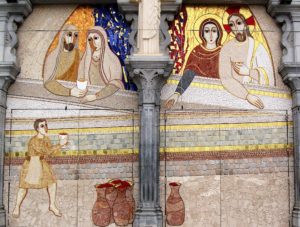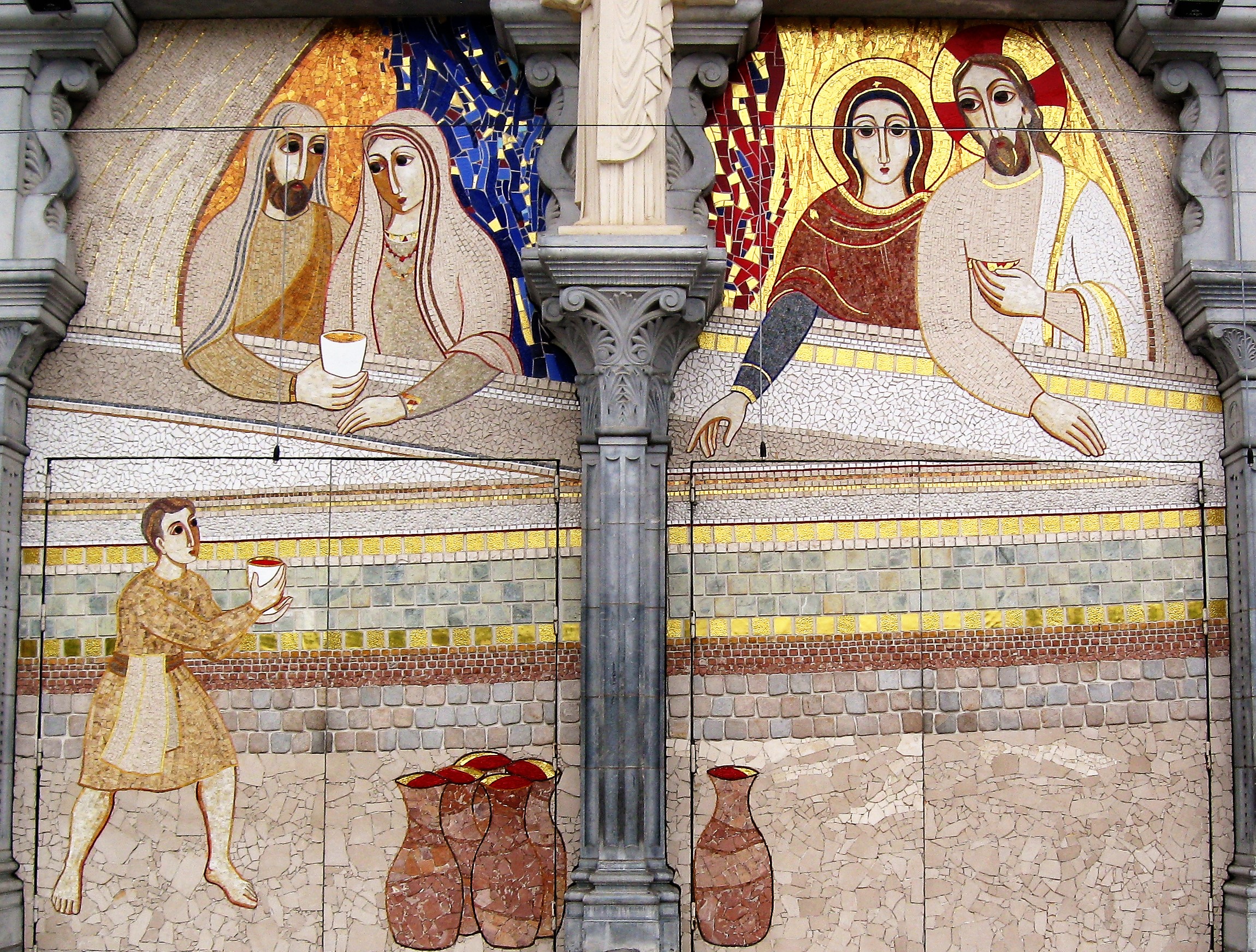
In this Sunday’s Gospel passage of the wedding feast at Cana, there is a theological portrait of both Mother Mary and prayer. Let’s look at the Gospel along five lines:
I. The place that Mary has – The text says, There was a wedding at Cana in Galilee and the mother of Jesus was there. Jesus and his disciples were also invited to the wedding.
A fascinating thing about these opening verses is that Mary almost seems to dominate the scene; the presence of Jesus is mentioned only secondarily. St. Thomas Aquinas notes that at Cana, Mary acts as the “go-between” in arranging a mystical marriage (Commentary on John, 98; and 2, 1, n.336, 338, and 343, 151-152). Once the marriage is arranged, she steps back; her final words to are these: “Do whatever he tells you.”
How many of us has Mary helped to find her Son and to find our place at the wedding feast of the Lamb? I know that it was Mary who drew me back to her Son when I had strayed.
II. The prayer that Mary makes – The text says, When the wine ran short, the mother of Jesus said to him, “They have no wine.”
Notice another central role that Mary has: intercessor. She is praying to her Son for others. There are three qualities to her prayer:
Discernment – Mary notices the problem, probably even before the groom and bride do. Indeed, mothers often notice the needs of their children before they do. Why didn’t Jesus notice? Surely, as God, He knew, but He waits for us to ask. Yes, God waits for us; He expects us to ask Him. In part this is respect; not all of us are ready to receive all His gifts. This expectation that we ask is also rooted in God’s teaching that we must learn to depend on Him and to take our many needs to Him. The Book of James says, You have not because you ask not (James 4:2).
Diligence – Simply put, Mary prays. Rather than merely fretting and being anxious, she goes directly to her Son out of love for the couple (us) and trust in her Son. She sees the need and gets right to the work of praying, of beseeching her Son.
Deference – Mary does not tell Jesus what to do, she simply points out the need: “They have no wine.” Mary is not directive, as if to say, “Here is my solution for this problem. Follow my plans exactly. Just sign here at the bottom of my plan for action.” Rather, she simply observes the problem and places it before her Son in confidence. He knows what to do and will decide the best way to handle things.
In this way Mary, models prayer for us. What wine are you lacking now? What wine do your children and grandchildren lack? Do you notice your needs and the needs of others and consistently pray? Or must things get critical for you to notice or pray? When you pray, do you go to the Lord with trust or with your own agenda?
So, Scripture teaches that Mary is the quintessential woman of prayer, a paragon of prayer. Not only does she intercede for us, she teaches us how to pray.
III. The portrait of Mary – The text says, Woman, how does this concern of yours affect me? My hour has not yet come. His mother said to the servers, “Do whatever he tells you.” Notice three things about this brief dialogue:
The title of Mary – Jesus calls her “woman.” In Jewish culture this was a respectful way for a man to address a woman, but it was unheard of for a son to address his mother in this fashion.
Hence, this text stands out as unusual and signals that Jesus is speaking at a deeper level. In the Johannine texts, Jesus always calls his Mother, “Woman.” This is in fulfillment of Genesis 3:15, which says, I will put enmity between you and the woman, and between your seed and her seed; he shall crush your head, while you strike at his heel. Thus, Jesus is saying that Mary is this woman who was prophesied.
Far from being disrespectful to Mary, Jesus is exalting her by saying that she is the woman who was prophesied; she is the woman from whose “seed” comes forth the Son destined to destroy the power of Satan.
In this sense Mary is also the new Eve. Jesus also calls her “Woman” at the foot of the cross; He is the new Adam while Mary is the new Eve, and the tree is the cross. Thus, just as humans got into trouble by a man, a woman, and a tree, so now we get out of trouble through the same path. Adam’s no is reversed by Jesus, who saves us by his yes. Eve’s no is reversed by Mary’s yes.
The tenacity of Mary – In Greek, Jesus’ words to his mother are these: τί ἐμοὶ καὶ σοί, γύναι – ti emoi kai soi, gunai (What to me and to thee, Woman?). When this phrase appears elsewhere in the Scriptures (e.g., Gen 23:15; 1 Kings 19:20) it usually indicates tension between the interlocutors. On the surface, it would seem that Jesus is resisting his mother’s attempt to involve him in this matter. What makes this interpretation odd, though, is that Mary doesn’t appear to interpret Jesus’ response as resistance.
Perhaps there was something in the tone of voice that Jesus used, or perhaps there was a look between them that resolved the tension and evoked Jesus’ sympathy for the situation. Whatever the case, Mary stays in the conversation with Jesus and overcomes whatever tension or resistance existed. In this we surely see her tenacity.
We can see Mary’s tenacity at other times: Though startled by the presence of the angel Gabriel, she engaged him in a respectful but pointed conversation in which she sought greater detail. Mary also hastened to visit her cousin Elizabeth, and in the dialogue that followed she proclaimed a Magnificat that was anything but a shy and retiring prayer. She joyfully acknowledged the Lord’s power in her life and all but proclaimed a revolutionary new world order.
To be tenacious means to hold fast despite obstacles or discouragements. However we interpret Jesus’ initial resistance to Mary’s concern, it is clear that she does not give up; she expects the Lord to answer her favorably. This is made clear by her confident departure from the conversation, when she turns to the stewards with this instruction: “Do whatever he tells you.”
The trust of Mary – She simply departs, telling the stewards, “Do whatever he tells you.” She does not hover. She does not come back and check on the progress of things. She does not try to control or manipulate the outcome. She simply departs and leaves it all to Jesus.
IV. The power of Mary’s prayer – Whatever his initial concerns regarding Mary’s request, Jesus goes to work. Now there were six stone water jars there for Jewish ceremonial washings, each holding twenty to thirty gallons. Jesus told them, “Fill the jars with water.” So they filled them to the brim. Then he told them, “Draw some out now and take it to the headwaiter.” So they took it. And when the headwaiter tasted the water that had become wine, without knowing where it came from—although the servers who had drawn the water knew—the headwaiter called the bridegroom and said to him, “Everyone serves good wine first, and then when people have drunk freely, an inferior one; but you have kept the good wine until now.”
If we do the math, we can estimate that Jesus produced almost 150 gallons of the best wine. Mary’s prayer and tenacity produced abundant results.
Sometimes the Lord tells us to wait so that He can grant further abundance. Scripture says, But they who wait for the LORD shall renew their strength; they shall mount up with wings like eagles; they shall run and not be weary; they shall walk and not faint (Isaiah 40:31).
The Catholic tradition of turning to Mary and regarding her as a special intercessor with particular power is rooted in this passage. Mary is not merely an intercessor for us, though; she is also a model. Following her example, we should persevere in prayer and go to the Lord with confident expectation of His abundant response. The effectual fervent prayer of a righteous man availeth much (James 5:16).
V. The product of Mary’s prayer – The text says, Jesus did this as the beginning of his signs at Cana in Galilee and so revealed his glory and his disciples began to believe in him.
At the conclusion of this Gospel is the significant result that many began to believe in the Lord as a result of this miracle. This is Mary’s essential role with reference to Jesus, that she should lead many souls to a deeper union with her Son. Having done so, she leaves us with this instruction: “Do whatever he tells you.”
Mary’s role is to hold up Christ for us to see, as she did at Bethlehem for the shepherds (and later the Wise Men) and for Simeon and Anna at the Temple. Her role is to point to His glory as she does here at Cana. Ultimately, Mary’s role is to hold Jesus’ body in her arms at the foot of the cross after He is taken down.
As a mother, Mary has a special role in the beginnings of our faith, in the infancy and childhood of our faith. The text says that many “began to believe.” In Greek grammar, this phrase is an example of an inceptive aorist, often used to stress the beginning of an action or the entrance into a state. Thus, Mary has a special role in helping to initiate our faith, in helping (by God’s grace) to birth Christ in us. As St. Thomas Aquinas says, she is the “go-between,” the great matchmaker in the mystical marriage of Christ and the soul. Having done that, her final words are these: “Do whatever he tells you.” And while she may draw back a bit, she continues to pray for us.
Here, then, are some biblical basics about Mother Mary, gleaned from this Gospel passage of the wedding feast at Cana.
Cross-posted at the Catholic Standard: Biblical Basics about Mother Mary – A Homily for the Second Sunday of the Year


Beautiful. What has always struck me, as does the whole event, is that it is apparent that Mary knew that her Son had the power to fix the impending wedding disaster.
John, the Beloved had to write about Mama Mary. I believe that Mama Mary, as she was bequeathed to John, told him not to write about her, write about HIM. But John had to, even, in just but two very important flashes. Woman, in the first miracle which is to stress, yes, she is the Woman in the proto-evangelium in Genesis, the first book of The Scriptures. Then Woman, in the last moment of JESUS’ life, ‘Woman behold thy son, son behold thy Mother’ which is Woman in the last book of The Scriptures, ‘TheWoman clothed with the sun’ in the Book of Revelation which John also wrote. Goodness, if our brethren in the Protestant denominations do not comprehend the importance of The Blessed Virgin Mary’s role in the salvation history, I do not know what. With the explanation of our Pope, I mean Monsignor Pope (heheheh) above, this should open up one’s heart to the veneration this most maligned Woman in history. As we Legion of Mary declare in our Antiphon, ‘Who is she that cometh forth as the morning rising, fair as the moon, bright as the Sun, terrible as an army set in battle array?’ YHWH SHEKINAH